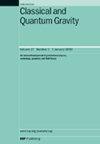Reconstructing source motion from gravitational wave strain
IF 3.7
3区 物理与天体物理
Q2 ASTRONOMY & ASTROPHYSICS
引用次数: 0
Abstract
Searches for un-modelled burst gravitational wave (GW) signals return potential candidates for short-duration signals. As there is no clear model for the source in these searches, one needs to understand and reconstruct the system that produced the GWs. Here, we aim to reconstruct the source motion and masses of a system based only on its GW strain. We train a normalising flow on two models, including circular orbits and random unphysical motion of two point masses. These models are used as a toy problem to illustrate the technique. We then reconstruct a distribution of possible motions of masses that can produce the given GW signal. We demonstrate the ability to reconstruct the full distribution of possible mass motions from strain data across multiple GW detectors. This distribution encompasses the degenerate motions that are expected to produce identical GW strains.从引力波应变重建震源运动
对未建模的爆发引力波(GW)信号的搜索会返回短持续时间信号的潜在候选者。由于在这些搜索中没有明确的来源模型,人们需要了解和重建产生gw的系统。在这里,我们的目的是重建一个系统的源运动和质量仅基于其GW应变。我们在两个模型上训练一个归一化流,包括圆形轨道和两个点质量的随机非物理运动。这些模型被用作一个玩具问题来说明该技术。然后,我们重建了可能产生给定GW信号的质量运动的分布。我们展示了从多个GW探测器的应变数据重建可能的质量运动的完整分布的能力。这个分布包含了期望产生相同GW应变的简并运动。
本文章由计算机程序翻译,如有差异,请以英文原文为准。
求助全文
约1分钟内获得全文
求助全文
来源期刊

Classical and Quantum Gravity
物理-天文与天体物理
CiteScore
7.00
自引率
8.60%
发文量
301
审稿时长
2-4 weeks
期刊介绍:
Classical and Quantum Gravity is an established journal for physicists, mathematicians and cosmologists in the fields of gravitation and the theory of spacetime. The journal is now the acknowledged world leader in classical relativity and all areas of quantum gravity.
 求助内容:
求助内容: 应助结果提醒方式:
应助结果提醒方式:


